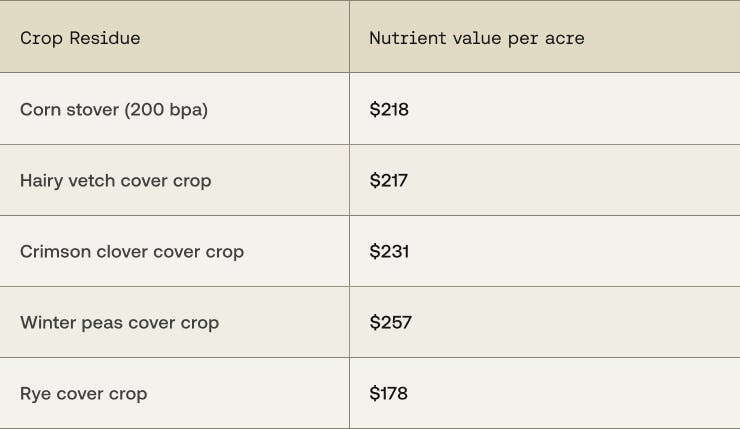
Every year, farmers apply fertilizer to ensure their crops have the nutrients they need to thrive. And every year, a major source of those same nutrients goes untapped, right under their boots.
We're talking about crop residue and cover crops. These materials are packed with nitrogen, phosphorus, and potassium—the same nutrients you pay for in synthetic form. But if those nutrients remain locked away in tough plant material, they can’t help your next crop. That's where nutrient recapture comes in.
At IMIO, we believe it’s time to stop thinking about residue management and start thinking about nutrient recapture—an approach that turns plant “waste” into nutrient value.
The Value Beneath Your Feet
Crop residues and cover crops aren't trash. They're fertilizer waiting to be released.
Let's take a look at the potential dollar value of common residue types, based on their nutrient content:

These figures combine the estimated market value of nitrogen, phosphorus, and potassium contained in the crop material. In many cases, you're looking at over $200 per acre of fertility value that's already in your field, already paid for in seed, labor, and biomass.
Farmers already know this value exists. The question is whether you can access it.
Why Nutrient Recapture Beats Residue Management
Residue management products focus on making plant residue "go away." But that's not the same as unlocking nutrients. Most of these products rely on low-activity, bacteria-only blends that fall short when it comes to breaking down lignin and cellulose—the tough stuff in stalks and stems that hold the nutrients in.
Re-Gen, IMIO's nutrient recapture product, is built to do something different: free those nutrients and return them to the soil, where your next crop can use them. These differences in product composition matter. Especially when it comes to fungi.
Here’s how it compares:

Fungi: The Key to Nutrient Access
Fungi are nature's best decomposers. They excel at breaking down lignin and cellulose. A 2025 study in Genome Biology put it clearly: “Fungi consistently act as the dominant decomposers... Bacteria predominantly exploit fungal degradation products.”
In short: fungi unlock the value, and bacteria follow behind. If your biological only contains bacteria, you’re missing the main driver of nutrient recapture.
Re-Gen includes fungi (plus bacteria and yeast) and uses a freeze-drying process to preserve microbial activity. This gives Re-Gen a broader spectrum of biology and higher effectiveness in the field.
Recapturing Value, Reducing Spend
If you’re spending $100–$200 per acre on synthetic fertilizer—and leaving another $200 per acre of organic fertility untouched—you’re missing a major opportunity.
Nutrient recapture closes that gap. It helps you:
- Reduce synthetic fertilizer dependence
- Improve ROI on cover crops
- Speed residue breakdown for cleaner seedbeds
- Restore microbial balance with a broader biological profile
Farmers who’ve adopted Re-Gen report not only faster decomposition and cleaner fields, but also peace of mind knowing they’re getting more from what they’ve already invested in. Read our case studies to learn more.
A New Way to Think About Fertility
Cover crops and residues are full of nutrients your crops need.
Nutrient recapture means recognizing and reclaiming that value. It’s not just good biology. It’s good business.
If you’re ready to stop leaving nutrient value on the table, let’s talk.





